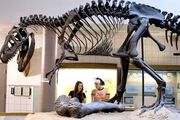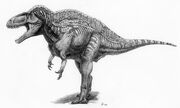
Allosauroidea is a superfamily of theropod dinosaurs. The Allosauroidea contains four families: Sinraptoridae, Neovenatoridae, Allosauridae, and Carcharodontosauridae. Most genera in the Allosauroidea consist of lightly-built, typically large theropods that bear a slight resemblance to spinosaurids. The first species of allosauroid to be discovered, Allosaurus, was the one of the first large theropods to be discovered, even before Tyrannosaurus rex, but after Megalosaurus. For at least 20 years, Allosaurus was the largest theropod known. Other allosauroids, such as Giganotosaurus and Carcharodontosaurus have also enjoyed brief periods in the title for the largest known theropods. Allosauroids are often referred to as carnosaurs or simply allosaurs.
Classification[]
Allosauroidea is a fairly large superfamily, consisting of at least four families. Classification of allosauroids has varied and changed vastly over the years. In the early years, from 1877 to the 1930's, all theropods that bore resemblance to Allosaurus were placed in its family, Allosauridae. When the skulls of Allosaurus and Carcharodontosaurus were examined and contrasted, the Allosauroidea was split into two families, the Allosauidae and the Carcharodontosauridae. Further study decades later revealed the Allosauridae family to be too broad; it in turn was split into the Neovenatoridae and Allosauridae. The most recently proposed family, the Sinraptoridae, contains some of the lesser-known allosauroids, such as Sinraptor and Yangchuanosaurus.
Taxonomy[]
Superfamily Allosauroidea[]
- Family Allosauridae
- Genus Allosaurus
- Genus Antrodemus
- Genus Epanterias (probable synonym of Allosaurus)
- Genus Saurophaganax
- Family Carcharodontosauridae
- Genus Acrocanthosaurus
- Genus Carcharodontosaurus
- Genus Eocarcharia
- Genus Giganotosaurus
- Genus Mapusaurus
- Genus Shaochilong
- Genus Tyrannotitan
- Family Neovenatoridae
- Genus Aerosteon
- Genus Australovenator
- Genus Chilantaisaurus
- Genus Fukuiraptor
- Genus Megaraptor
- Genus Neovenator
- Genus Orkoraptor
- Family Sinraptoridae
- Genus Leshansaurus
- Genus Metriacanthosaurus
- Genus Sinraptor
- Genus Yangchuanosaurus
Phylogeny[]
The clade Allosauroidea was originally proposed by Phil Currie and Zhao (1993; p. 2079), and later used as an undefined stem-based taxon by Paul Sereno (1997). Sereno (1998; p. 64) was the first to provide a stem-based definition for the Allosauroidea, defining the clade as "All neotetanurans closer to Allosaurus than to Neornithes." Kevin Padian (2007) used a node-based definition, defined the Allosauroidea as Allosaurus, Sinraptor, their most recent common ancestor, and all of its descendants.
| Allosauroidea |
|
Features[]

Acrocanthosaurus, an allosaur with a resemblance to the Spinosaurids.
Allosauroids are often regarded by paleobiologists as the quintessential theropods: many of them enormous and all very powerful hunters. They vary in shape; however most have a slender build. Although the typical allosauroid is more slender than most tyrannosaurs, all would have been incredibly powerful in life. Allosauroids bear several similarities with their distant relatives the spinosauroids, namely a stiff, tapering tail, lightly built body, and long front legs compared to those of tyrannosaurids. Like spinosaurs, the arms of allosaurs are long and end in three digits each equipped with a hook-like claw. Most allosauroids have skulls with enormous fenestrae (openings) that may have served any number of purposes. They obviously held the brain and sensory organs; however they may have acted like shock absorbers, allowing allosauroids to bite with considerable force. Allosauroids likely did not have a bone-crunching bite as some tyrannosaurs did, however. The teeth of allosauroids were thin and serrated, and have often been compared to steak knives. The allosauroids probably sliced flesh from their prey, causing the prey to bleed to death.
Some allosauroids had a body design especially like that of a spinosaurid. The Early Cretaceous predator Acrocanthosaurus had extended vertebrae, much like those of the Spinosaurid, Suchomimus. These vertebrae may have supported a skin sail or a fatty hump.